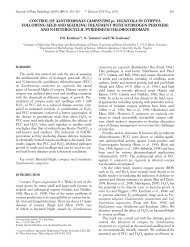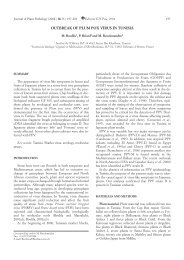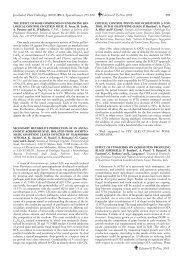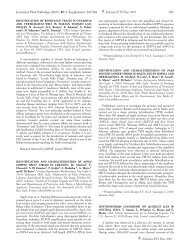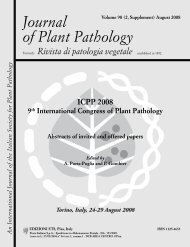Journal of Plant Pathology (2010), 92 (4, Supplement ... - Sipav.org
Journal of Plant Pathology (2010), 92 (4, Supplement ... - Sipav.org
Journal of Plant Pathology (2010), 92 (4, Supplement ... - Sipav.org
You also want an ePaper? Increase the reach of your titles
YUMPU automatically turns print PDFs into web optimized ePapers that Google loves.
<strong>Journal</strong> <strong>of</strong> <strong>Plant</strong> <strong>Pathology</strong> (<strong>2010</strong>), <strong>92</strong> (4, <strong>Supplement</strong>), S4.71-S4.105 S4.91<br />
Powdery mildew, caused mostly by Podosphaera xanthii, is an<br />
important disease <strong>of</strong> cucurbits in the Mediterranean basin. The<br />
fungicides known as QoI are largely used to control the disease,<br />
but resistance has been observed in many phytopathogenic fungi,<br />
including P. xanthii. Here we present the results <strong>of</strong> a monitoring<br />
<strong>of</strong> resistance to trifloxystrobin in P. xanthii populations in Apulia.<br />
Sixty-four isolates <strong>of</strong> P. xanthii were sampled from 32 cucurbit<br />
fields in 2002-2007, and assayed at seven trifloxystrobin (Flint®)<br />
concentrations. Alternative respiration was inhibited by adding 1<br />
mg ml -1 <strong>of</strong> salicylhydroxamic acid to fungicide suspensions. Portions<br />
<strong>of</strong> zucchini cotyledons (cv. Diamant 1) were dipped for 1<br />
min in the fungicide suspension, placed on Blaich medium in<br />
Petri dishes, inoculated at a single point with about 20 conidia,<br />
and maintained at 25°C under a 12 h photoperiod. After 10 days,<br />
the percentage <strong>of</strong> infected surface was estimated using an empirical<br />
scale based on six infection classes, and EC 50 and MIC were<br />
assessed. Results pointed out a high variability in the response to<br />
trifloxystrobin, with EC 50 ranging from 375 µg ml -1 , and<br />
MIC from 10 to >375 µg ml -1 . About half <strong>of</strong> isolates had EC 50<br />
>375 µg ml -1 trifloxystrobin, a concentration three times greater<br />
than the normal field rate (125 µg ml -1 ), with no differences attributable<br />
to the host plants or the geographical origin. In conclusion,<br />
resistance to QoIs is very common in Apulia, and this<br />
should induce growers to implement more stringent anti-resistance<br />
strategies.<br />
FIRST REPORT OF LEAF SPOT CAUSED BY STEMPHYLI-<br />
UM HERBARUM ON BORAGO OFFICINALIS. L.C. Moretti,<br />
M. Quaglia, M. Orfei, C. Cappelli. Dipartimento di Scienze Agrarie<br />
e Ambientali, Università degli Studi, B<strong>org</strong>o XX Giugno 74, 06121<br />
Perugia, Italy. E-mail: chiaraluce.moretti@unipg.it<br />
Borage (Borago <strong>of</strong>ficinalis L.) is an ornamental plant, widely<br />
present in nature in different areas <strong>of</strong> Italy. During spring 2009,<br />
in private gardens and on the border <strong>of</strong> Trasimeno lake (Central<br />
Italy), leaf spots on cultivated and wild borage plants were observed.<br />
Initial symptoms were recorded on basal leaves as small<br />
brown circular spots (2 mm diameter), greyish-white in the middle<br />
and surrounded by a reddish halo. The symptoms developed<br />
on the upper leaves and later severe yellowing and necrosis <strong>of</strong> the<br />
leaf tissue were observed. Due to unfavourable climate conditions<br />
(hot temperature and low humidity), new foliages did not<br />
show symptoms and the disease disappeared but the plants, especially<br />
those present in the gardens, seemed less vigorous. A fungus,<br />
morphologically identified as Stemphylium herbarum Simmonds<br />
[anamorph <strong>of</strong> Pleospora herbarum (Fr.) Rabenh.], was<br />
consistently isolated. To assess its pathogenicity to borage plants,<br />
two fungal isolates were used. <strong>Plant</strong>s were sprayed with conidial<br />
suspensions (5x10 5 conidia ml -1 ) from 10-day-old agar cultures.<br />
After 7-8 days, the plants inoculated with both fungal isolates<br />
showed small spots, identical to those observed under natural<br />
conditions, whereas no symptoms were observed on control<br />
plants sprayed with water. S. herbarum was consistently reisolated<br />
from inoculated borage leaves. The fungus is known to cause leaf<br />
spots on several herbaceous hosts, including lettuce and onion.<br />
However, to our knowledge, this is the first report <strong>of</strong> a leaf spot<br />
disease <strong>of</strong> borage caused by S. herbarum.<br />
MULTIPLE BOTRYOSPHAERIACEAE INFECTION IN<br />
FOREST TREES: SYNERGISTIC OR ANTAGONISTIC IN-<br />
TERACTION? S. Moricca 1 , A. Uccello 1 , E. Turco 2 , B. Ginetti 1 ,<br />
A. Ragazzi 1 . 1 Dipartimento di Biotecnologie Agrarie, Sezione di<br />
Protezione delle Piante, Piazzale delle Cascine 28, 50144 Firenze,<br />
Italy. 2 Istituto per la Protezione delle Piante del CNR, Via Madonna<br />
del Piano, 50019 Sesto Fiorentino (FI), Italy. E-mail: andrea.uccello@unifi.it<br />
Botryosphaeriaceae an Ascomycetes family well known as endophytes<br />
<strong>of</strong> woody hosts under temperate and subtropical climates.<br />
It includes several species that may turn to a pathogenic<br />
habitus when hosts undergo physiological stress. Previous pathogenicity<br />
studies have focused their attention on the interactions<br />
between a single fungal species and their hosts. However, the<br />
type <strong>of</strong> interaction established when two or more botryosphaeriaceous<br />
fungi colonize the same host tissues is till unknown. Isolates<br />
<strong>of</strong> Botryosphaeria dothidea, Diplodia seriata and Ne<strong>of</strong>usicoccum<br />
parvum were tested on two-year-old seedlings <strong>of</strong> Acer<br />
campestre, Carpinus betulus, Fraxinus excelsa and Quercus cerris<br />
to verify disease severity and to evaluate the effect <strong>of</strong> single and<br />
combined infections. N. parvum proved the most virulent <strong>of</strong> the<br />
three species, causing lesions significantly larger than those<br />
caused by the other species. Seedlings inoculated with the mixture<br />
<strong>of</strong> isolates showed smaller lesions than those caused by N.<br />
parvum alone. These preliminary results allow us to hypothesize<br />
that a sort <strong>of</strong> antagonistic interaction may occur between<br />
Botryosphaeriaceae in host tissues.<br />
STUDIES ON THE AETIOLOGY OF THE DISEASE<br />
KNOWN AS OCHRACEOUS LEAF SPOTS OF APPLE IN<br />
FRIULI VENEZIA GIULIA. S. Moruzzi, M. Martini, R.<br />
Musetti, P. Ermacora, S. Borselli and R. Osler. Dipartimento di<br />
Biologia e Protezione delle Piante, Università degli Studi, Via delle<br />
Scienze 208, 33100 Udine, Italy. E-mail: serena.moruzzi@uniud.it<br />
An apple disease known as ochraceous leaf spots is known<br />
since 1950, but its aetiology is still unclear. The disease is common,<br />
especially in orchards where apples are grown under <strong>org</strong>anic<br />
regime. In Friuli Venezia Giulia, this disease is present in different<br />
areas, in orchards <strong>of</strong> commercial and autochthonous apple<br />
varieties. Symptomatic leaves were sampled in three farms to<br />
study disease aetiology. In total 825 fungal colonies were obtained,<br />
grouped according to morphological features, and characterized<br />
by molecular tools, by analysis <strong>of</strong> rDNA ITS region. Isolations<br />
yielded fungi belonging to Phoma spp. (about 37% subdivided<br />
in: P. macrostoma, 16.9%; P. glomerata, 4%; P. epicoccina,<br />
15%; P. exigua, 2.5%), Alternaria spp. (about 35%), and other<br />
minor genera. In pathogenicity tests, leaves inoculated with all<br />
four Phoma species developed classical necrotic lesions, while Alternaria<br />
spp. developed some atypical necrosis, suggesting Phoma<br />
spp. as the most probable causal agent <strong>of</strong> leaf spots. Portions <strong>of</strong><br />
symptomless leaves were also investigated: Phoma spp. accounted<br />
for 23% <strong>of</strong> the obtained colonies and Alternaria spp. for 58%,<br />
indicating that the latter fungal genus might behave mainly as a<br />
plant endophyte. In plants with leaf symptoms, part <strong>of</strong> the xylem<br />
appeared to be damaged under the electron microscope. Therefore,<br />
further investigations were conducted using different techniques,<br />
showing that P. macrostoma colonized also young branches.<br />
P. macrostoma isolates from leaves and young branches were<br />
characterized molecularly based on the ITS and ″-tubulin gene<br />
sequences. No molecular differences were found in these genomic<br />
regions among fungal isolates.<br />
FUNGAL ENDOPHYTES IN NEEDLES AND BRANCHES<br />
OF PICEA ABIES FROM THE PANEVEGGIO FOREST. R.<br />
Musetti 1 , R. Polizzotto 1 , F. De Luca 2 , S. Grisan 1 , R. Osler 1 . 1 Dipartimento<br />
di Biologia e Protezione delle Piante, Università degli



